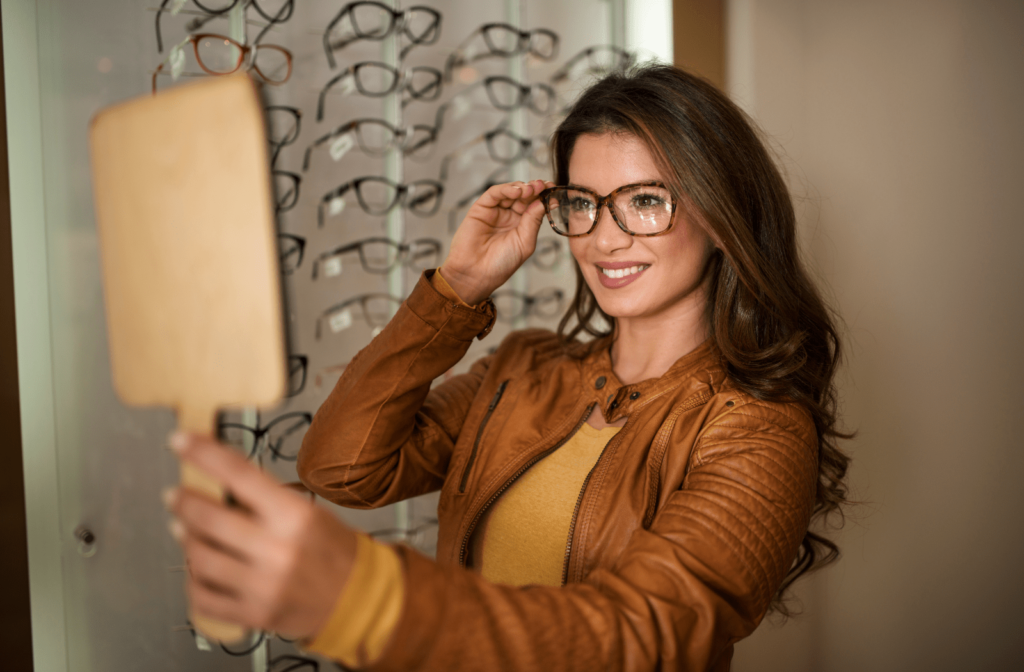You may be tempted to find the cheapest pair of glasses regardless of how they fit. However, glasses must fit your face. When you buy from a professional like an optometrist or optician, you gain the advantage of their knowledge on how the frames should fit.
Suppose you’re the lone wolf type and prefer to shop independently without assistance. In that case, there’s still no reason you can’t get glasses that fit. This article explores some measurement terminology you’ll likely encounter and what to look for regarding fit. In addition, we’ll briefly touch on some issues you may experience with improperly fitting glasses.
Key Measurements to Consider
In most cases, a pair of frames will have a series of 3 numbers inside one of the arms. These are measurements in millimetres (mm) and cover three key aspects of the frames:
- Lens width: The total horizontal measurement of the lenses at their widest part is the first 2 numbers in the series. 30–60 mm are common lens widths.
- Bridge width: The second set of numbers in the series is the bridge width, which is the piece between the lenses that “bridges” your nose. 12–24 mm are average widths.
- Arm length: The last numbers in the series are the measurement from the hinge of the frames all the way back. 115–155 mm are common lengths.
In addition to these three frame measurements, your pupillary distance (PD) is also an important consideration. Again in mm, this is the distance between your pupils while looking straight ahead. When relating this to the frames, your PD should end up at the center of each lens.
How Should Glasses Fit Your Face?
If you have the above measurements, simply try on frames with similar or the exact measurements. Even with the same information, some styles fit differently, so there is still a certain degree of trial and error. This is another benefit of being able to physically try the glasses on.
However, suppose you don’t know your measurements. In that case, the trial and error factor is increased a bit. Here are a few things to consider when trying glasses on:
- Visual: When wearing glasses, they should not rest on your cheeks—even when your cheeks move up while smiling. In addition, the frames should extend no further than level with your eyebrows, and your eye should be centred in the lens for an accurate PD measurement.
- Comfort: Glasses should rest gently on your face and not cause discomfort. Pay attention to your ears and nose for any signs of pinching or squeezing while trying on frames.
- Style: Style doesn’t typically factor into how glasses fit (though certain types do fit differently), but your glasses should look great. If you’re not happy with how they look, you may be more likely not to wear them. And not wearing glasses when you need them could pose its own risk.
Signs Your Glasses Don’t Fit
How comfortable the glasses are when you try them on is a pretty good indicator of how well they fit. But here are some specific signs that the frames don’t fit your face:
- Slipping off: You should be able to look down or tilt your head and shake it lightly without your glasses sliding down or moving out of place.
- Imprints: As mentioned above, your glasses should fit comfortably and rest lightly on your face. If you remove them and there are imprints or red marks where they sit on your nose, they likely don’t fit. However, many glasses have adjustable nose pieces to accommodate different faces.
- Limited vision: Depending on the design and how they sit on your face, your peripheral vision may be affected. It’s normal to have some limited vision outside of the lens, but you should consider how much while trying the glasses on.
- Too close: Your eyelashes and cheek should not touch the frames or lenses. If they do, the glasses are not sitting correctly on your face.
Problems With Wearing Glasses That Don’t Fit
When it comes to glasses that don’t fit, sometimes everything seems great at first. But over time, you may notice other symptoms that could indicate glasses that fit poorly. Suppose you’re experiencing any of these things. In that case, it’s worth chatting with your eye doctor about the options (and they can rule out any other possible issues).
When your glasses don’t fit correctly, you may experience some pain, including:
- Constant headaches
- Eyestrain
- Dizziness or trouble focusing
- Squinting
These things don’t automatically mean that your glasses don’t fit. For example, headaches and eyestrain could be caused by digital eye strain if you spend a lot of time on devices. If your new glasses also include a new prescription, some of these symptoms could simply be your eyes adjusting to the new lenses.
Let Us Help You Choose the Right Glasses
Getting high-quality glasses that fit can be daunting if you try to do it alone. And if you spend your hard-earned money on glasses that should last you several years at least, you want to ensure you’re getting the perfect pair for your face.
Stop by our office and let our professional staff help. Not only will we help find frames that fit and lenses suited to your vision needs, but we’ll also make sure you look great!





